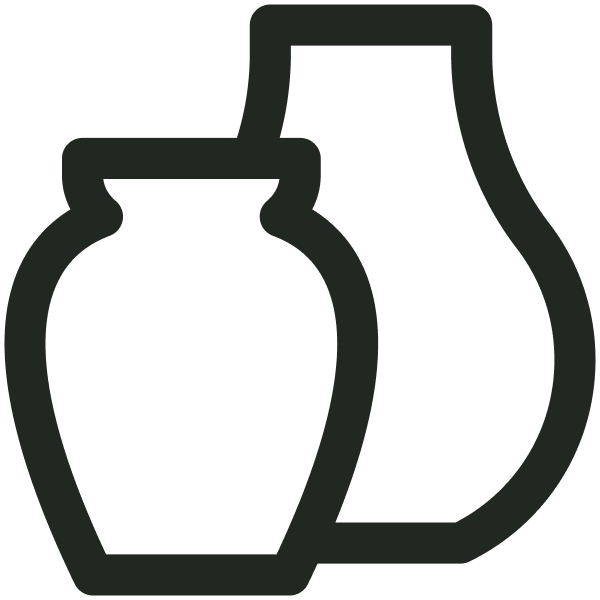We’re quite proud of the fact that our candle bags are 100% compostable — both at home and in an industrial facility! Why did we choose compostable packaging you might ask? Well, while recycling is a great option when items are properly cleaned and sorted, you might notice that just like your (nearly) empty glass candle vessels, our bags can be left with some residual wax inside after you pour your candle. To make it easy on you, and the recycling stream, we opted for compostable bags that return to their organic state — soil — at the end of their product lifecycle. With proper disposal, your candle bag will biodegrade into healthy compost leaving no micro-plastics behind.
If you don’t live in a place where household compost materials are collected by the municipality or have an accessible industrial composting facility nearby, home composting might be for you. Not only is compost soil good for your garden and house plants, it’s good for the environment as well. If you didn’t know, food waste that ends up in landfill breaks down anaerobically and releases methane — a gas responsible for up to 25% of the global warming we are experiencing today.
Here are a few tips on how to compost at home and dispose of your empty candle bags.
Find a compost location
First up, you’ll need to find a good spot for your compost pile or bin. An ideal location is flat and well-drained so the compost doesn’t get too soggy. Look to avoid direct sunlight as too much sun can kill beneficial microorganisims. Make sure the location is easily accessible for adding new materials and regularly mixing the compost to keep it aerated. Of course, consider your neighbors and any smells than might come from the pile. If avoiding pest is important, opt for a compost bin with lid rather than a loose pile.
Build your compost
Once you have your location and bin setup it’s time to get your compost base started. You’ll need a balance of ‘browns’ and ‘greens’. Browns include carbon-rich materials like dry leaves, dry grass clippings, sawdust, old newspapers (and empty candle bags). Greens are your kitchen scraps, tea bags, coffee grounds, fresh grass clippings or green leafy materials. Avoid meat, fish, dairy and greasy foods as they can attract pests. Weeds and pet waste also should not go in the compost.
As you build your compost base, begin with a layer of browns followed by a layer of greens. Put a little water on the compost so it’s moist, but not saturated. Continue layering browns and greens as you add to your compost. When you add greens, top with browns to keep the the mixture even and deter flies or pests. Having a bag of dried leaves handy near your compost is an easy way to keep up the right ratio.

Maintain your compost
Find a cadence that works for you to maintain your compost. Proper maintenance includes ‘turning’ the compost periodically to ensure enough airflow in the mixture. And monitoring the moisture level. Healthy compost needs the right combination of browns, greens, moisture and air.
To turn your compost, you can use a pitchfork or a compost crank to aerate the pile. Simply pull the inside materials out and push the outer materials in towards the middle of the pile. The more your turn your pile, the faster it will break down.
If you’re adding a balance of brown and green materials to the compost, it should retain the right moisture level — like that of a damp sponge. If it’s too dry, try adding some water as you mix the browns and greens together. During the hot summer months, you may need to add more water to keep the pile from drying out. If your compost becomes too soggy, simply mix in more browns.

Composting candle bags
Our 100% compostable candle bags are perfectly suitable for your home compost. To help them break down faster, we recommend cutting them up into small pieces before placing in your compost. This exposes more surface area of the bag to the microorganisms responsible for decomposing, speeding up the process.

Dos, don’ts and troubleshooting
Composting doesn’t have to be confusing. Once you get the hang of what goes in, what doesn’t and how to handle any problems that pop up, it’ll feel super simple. Here’s a hit list to get you started.
What goes in
| Brown materials (carbon-rich) | Green materials (nitrogen-rich) |
| Fall leaves | Food & veggies scraps |
| Dried grass clippings & pine needles | Green grass & yard clippings |
| Old plant stems & twigs | Coffee grounds & filters |
| Plain shredded paper & paper bags | Tea bags |
| Uncoated shredded cardboard | Crushed egg shells |
What doesn't go in
| Meat, fish & bones |
| Cheese & dairy products |
| Pet waste & cat litter |
| Fats, oils, grease |
| Coated paper |
| Invasive, diseased or herbicide treated plants |
| Dryer lint |
| Glass, metal, plastic |
Troubleshooting
Flies and pests
- Uncovered food scraps — use a lid / cover or a layer of browns on top
- Wrong materials in pile — check for ‘What doesn’t go in’
- Enclosure isn’t constructed properly — check for holes larger than 1/4 inch and make sure the bin has both a lid and a floor.
Strong odors
- Ensure you have enough browns
- Turn the compost regularly to aerate
- Monitor moisture — it should be damp, not soggy
Slow decomposition
- Check for correct levels of moisture, air and nitrogen (greens)
Finished compost & usage
You’ll know your compost is ready to use when there are no recognizable bits of food or other organic matter — and the soil is dark and crumbly with a rich earthy smell.
How should you use it when it’s done? Sub it in for potting soil in your potted plants and container gardens. Blend it with the dirt already in your garden to increase soil health. Use in place of fertilizer on the lawn or flowers. Just make sure to use your compost within 6-12 months of creating it to provide optimal nutrient benefits for your plants.

Starting a home compost might seem a little daunting at first, but it can be a very simple, rewarding habit to get into that benefits your own garden, and the environment.
Need a few Clean Candle bags to help build your compost base? We recommend No 01, No 02, No 05, No 08, No 11 and No 12 to get you in the gardening mood.




